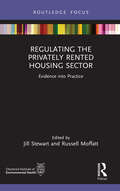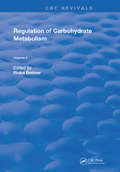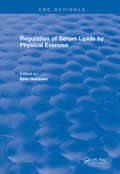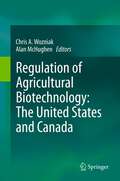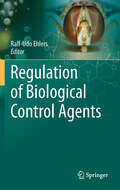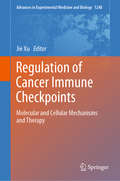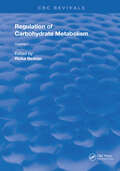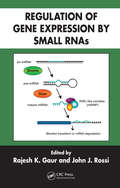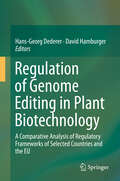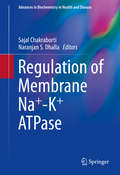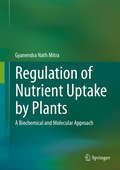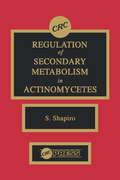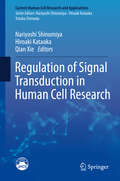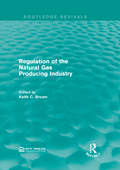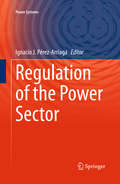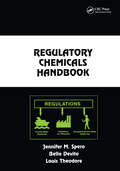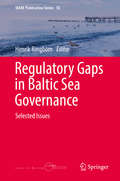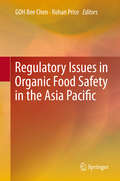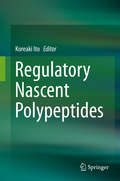- Table View
- List View
Regulating Water Security in Unconventional Oil and Gas (Water Security in a New World)
by Chad Staddon Regina M. Buono Elena López Gunn Jennifer McKayThis book addresses the need for deeper understanding of regulatory and policy regimes around the world in relation to the use of water for the production of ‘unconventional’ hydrocarbons, including shale gas, coal bed methane and tight oil, through hydraulic fracturing. Legal, policy, political and regulatory issues surrounding the use of water for hydraulic fracturing are present at every stage of operations. Operators and regulators must understand the legal, political and hydrological contexts of their surroundings, procure water for use in the fracturing and extraction processes, gain community cooperation or confront social resistance around water, collect flow back and produced water, and dispose of these wastewaters safely. By analysing and comparing different approaches to these issues from around the globe, this volume gleans insights into how policy, best practices and regulation may be developed to advance the interests of all stakeholders. While it is not always possible to easily transfer ‘good practice’ from one place to another, there is value in examining and understanding the components of different legal and regulatory regimes, as these may assist in the development of better regulatory law and policy for the rapidly growing unconventional energy sector.The book takes an interdisciplinary approach and includes chapters looking at water-energy nexus security in general, along with issue-focused and geographically-focused case studies written by scholars from around the world.Chapter topics, organized in conjunction with the stage of the shale gas production process upon which they touch, include the implications of hydraulic fracturing for agriculture, municipalities, and other stakeholders competing for water supplies; public opinion regarding use of water for hydraulic fracturing; potential conflicts between hydraulic fracturing and water as a human right; prevention of induced seismic activity, and the disposal or recycling of produced water. Several chapters also discuss implications of unconventional energy production for indigenous communities, particularly as regards sustainable water management. This volume will be of interest to scholars and students of energy and water, regulators and policymakers and operators interested in ensuring that they align with emergent best global practice.
Regulating the Collaborative Economy in the European Union Digital Single Market
by Marco IngleseThis book critically assesses how the rise of the collaborative economy in the European Union Digital Single Market is disrupting consolidated legal acquisitions, such as classical internal market categories, as well as the applicability of consumer protection, data protection, and labour and competition law. It argues that the collaborative economy will, sooner or later, require some sort of regulatory intervention from the European Union. This regulatory intervention, far from stifling innovation, will benefit online platforms, service providers and users by providing them with a clearer and more predictable environment in which to conduct their business. Although primarily intended for academics, this book also appeals to a wider readership, including, but not limited to, national and international regulators, private firms and lobbies as well as online platforms, consumer associations and trade unions.
Regulating the Privately Rented Housing Sector: Evidence into Practice (Routledge Focus on Environmental Health)
by Jill Stewart Russell MoffattThis book explores theory and practice in the complex policy area of privately rented housing in England, with a particular focus on environmental and public health. Bringing together a range of both academic and practicing experts in the field, it responds to the rapid growth and changing nature of the sector and considers the range of options available to local authorities in ensuring more effective regulation strategies. This book: Creates a key, up-to-date professional resource for housing regulation based on road-tested academic course material. Breaks down strategies and practices to an implementational level. Provides impetus to leaders, practitioners, and students to both deliver and reflect on improved regulation. Explores responses to various stakeholder needs through the lens of protecting and supporting tenants. This book will interest professionals working in public health, housing, and local authorities, as well as environmental health and housing academia. Students across environmental health, social work, nursing, and other disciplines will also find this appealing.
Regulation Fixtures in Hydronic Heating Installations: Types, Structures, Characteristics and Applications (Studies in Systems, Decision and Control #187)
by Damian Piotr MuniakThe book focuses on design and computational issues related to fixtures and armatures in hydronic heating installations, especially regulation valves, their selection, operating principles, types and construction. The analysis is complemented by connection diagrams, drawings, photos of the valves and computational examples of their selection and operation parameters when used in a pipework and a controlled object, like a radiator. It also discusses issues related to the so-called valve authority, one of the main parameters determining the quality of the valve regulation process. Further, it includes an extensive theoretical framework along with a detailed mathematical analysis and proposes new algorithms, which have been verified and confirmed experimentally. Based on this analysis, the book presents the author’s analytical approach for sizing a regulation valve, as well as an innovative design solution for a regulation valve without the limitations of the valves currently available on the market. Lastly, it introduces a new verified method of calculating the valve pre-setting. Intended for engineers dealing with heating issues, scientists and students studying environmental engineering, energetics and related fields, the book is also useful for lecturers, designers, and those operating heating installations, as well as authors of computer programs for thermal and hydraulic balancing of heating installations.
Regulation Of Carbohydrate Metabolism: Volume II
by Rivka BeitnerThis text comprises of two volumes discussing the regulation of carbohydrate metabolism.
Regulation Of Serum Lipids By Physical Exercise
by HietanenThe aim of this book is to concentrate on the role of physical training in the regulation of serum lipids in healthy man. This book will try to estimate the power of regular exercise and the intensity of exercise in the regulation of plasma lipid and lipoprotein concentrations, with the ultimate goal being to find out the basic mechanisms which mediate the exercise-induced changes in serum lipid profile.
Regulation of Agricultural Biotechnology: The United States and Canada
by Chris A. Wozniak Alan MchughenAgricultural biotechnology takes many forms and applications, with the number and diversity of products ever increasing. With this rapid development, regulatory authorities have sought to keep pace through regulatory adjustments and advances to ensure the safe and beneficial use of this critical technology. The regulatory systems for the U.S. and Canada are not static and must evolve in order to maintain relevance, efficiency and applicability to the challenges encountered. The diverse authors, drawn from the biotechnology industry, academia, government research and regulatory agencies, offer their perspectives of the historical and current system and suggest where it can be improved in the future. Based upon vast experience interacting with the regulatory system, the editors and authors offer demystifying views of the US and Canadian regulatory structures and how they came to be. We know of no other effort to present the biotechnology regulatory systems of the US and Canada in an open forum which will benefit those in the regulated community as well as those charged with oversight of the products of biotechnology, and ultimately the consumer!
Regulation of Biological Control Agents
by Ralf-Udo EhlersThis book presents a comprehensive compilation of registration requirements necessary for authorisation of biological control agents (viruses, bacteria, fungi, active substances of natural origin and semiochemicals) in OECD countries. It also reviews data requirements for invertebrate agents (insect, mites and nematodes) and provides proposals for harmonisation of the regulation process and guidelines for completion of application forms. Based on results of the EU REBECA Policy Support Action, which gathered experts from academia, regulation authorities and industry, risks and benefits of the specific agents were reviewed and proposals for a more balanced registration process elaborated, including recommendations for acceleration of the authorisation process and discussions on trade-off effects and policy impacts. All these aspects are covered in detail in this book, which points the way forward for enhanced utilisation of biological control agents.
Regulation of Ca2+-ATPases,V-ATPases and F-ATPases
by Naranjan S. Dhalla Sajal ChakrabortiThe biological membranes of cellular organization enfold an important group of membrane proteins called the ATPases, which are not only versatile in maintaining chemical gradient and electrical potential across the membrane but also bring metabolites necessary for cell metabolism and drive out toxins, waste products and solutes that otherwise can curb cell functions. ATPases are distributed virtually in all live forms starting from unicellular to multicellular and also in viruses. There are different types of ATPases, which differ in function and structure and in the type of ions they transport. The three main types of the ion pump ATPase family are: (i) P-type ATPases that transport different ions across membranes and Ca2+ATPases belongs to this catagory (ii) F-type ATPase in mitochondria, chloroplasts and bacterial plasma membranes produce ATP using the proton gradient; and (iii) V-type ATPase catalyzes ATP hydrolysis to transport solutes and maintains acidic pH in organelles like lysosomes. Genetic defects in either of the ATPases cause several diseases and a number of researches have demonstrated the involvement of the members of ATPases in the cell pathology and diseases, thereby penetrating exciting new areas of our understanding. In this book, the authors summarize recent knowledge about the molecular mechanisms associated with Ca2+-ATPase, V-ATPase and F-ATPase in intracellular and extracellular Ca2+ transport, mitochondrial ATP synthase, vesicular H+ transport, and lysosomal pH regulation. This book thereby bridges the gap between fundamental research and biomedical and pharmaceutical applications. The book provides an informative resource to improve ATPase research and modern therapeutic approaches toward different life threatening diseases that are associated with dysregulation of the ATPases.
Regulation of Cancer Immune Checkpoints: Molecular and Cellular Mechanisms and Therapy (Advances in Experimental Medicine and Biology #1248)
by Jie XuThis book systematically reviews the most important findings on cancer immune checkpoints, sharing essential insights into this rapidly evolving yet largely unexplored research topic. The past decade has seen major advances in cancer immune checkpoint therapy, which has demonstrated impressive clinical benefits. The family of checkpoints for mediating cancer immune evasion now includes CTLA-4, PD-1/PD-L1, CD27/CD70, FGL-1/LAG-3, Siglec-15, VISTA (PD-1L)/VSIG3, CD47/SIRPA, APOE/LILRB4, TIGIT, and many others. Despite these strides, most patients do not show lasting remission, and some cancers have been completely resistant to the therapy. The potentially lethal adverse effects of checkpoint blockade represent another major challenge, the mechanisms of which remain poorly understood. Compared to the cancer signaling pathways, such as p53 and Ras, mechanistic studies on immune checkpoint pathways are still in their infancy. To improve the responses to checkpoint blockade therapy and limit the adverse effects, it is essential to understand the molecular regulation of checkpoint molecules in both malignant and healthy cells/tissues. This book begins with an introduction to immune checkpoint therapy and its challenges, and subsequently describes the regulation of checkpoints at different levels. In closing, it discusses recent therapeutic developments based on mechanistic findings, and outlines goals for future translational studies. The book offers a valuable resource for researchers in the cancer immunotherapy field, helping to form a roadmap for checkpoint regulation and develop safer and more effective immunotherapies.
Regulation of Carbohydrate Metabolism(1985): Volume I
by BeitnerFirst Published in 1985. A collaboration of the latest research on regulation of carbohydrate metabolism.
Regulation of Gene Expression by Small RNAs
by John J. Rossi Rajesh K. GaurNew Findings Revolutionize Concepts of Gene FunctionEndogenous small RNAs have been found in various organisms, including humans, mice, flies, worms, fungi, and bacteria. Furthermore, it's been shown that microRNAs acting as cellular rheostats have the ability to modulate gene expression. In higher eukaryotes, microRNAs may regulate as much as 50 p
Regulation of Genome Editing in Plant Biotechnology: A Comparative Analysis of Regulatory Frameworks of Selected Countries and the EU
by Hans-Georg Dederer David HamburgerThis book provides in-depth insights into the regulatory frameworks of five countries and the EU concerning the regulation of genome edited plants. The country reports form the basis for a comparative analysis of the various national regulations governing genetically modified organisms (GMOs) in general and genome edited plants in particular, as well as the underlying regulatory approaches.The reports, which focus on the regulatory status quo of genome edited plants in Argentina, Australia, Canada, the EU, Japan and the USA, were written by distinguished experts following a uniform structure. On this basis, the legal frameworks are compared in order to foster a rational assessment of which approaches could be drawn upon to adjust, or to completely realign, the current EU regime for GMOs. In addition, a separate chapter identifies potential best practices for the regulation of plants derived from genome editing.
Regulation of Membrane Na+-K+ ATPase
by Naranjan S. Dhalla Sajal ChakrabortiNa+-K+ ATPase or Na-pump ATPase, a member of "P"-type ATPase superfamily, is characterized by association of multiple isoforms mainly of it's α- and β- subunits. At present four different α- (α-1,α-2,α-3 and α-4) and three β- (β-1, β-2, and β-3) isoforms have been identified in mammalian cells and their differential expressions are tissue specific. Regulation of Na+-K+ ATPase activity is an important but a complex process, which involves short-term and long-term mechanisms. Short-term regulation of Na+-K+ ATPase is either mediated by changes in intracellular Na+ concentrations that directly affect the Na+-pump activity or by phosphorylation/dephosphorylation-mediated by some stimulants leading to changes in its expression and transport properties. On the other hand, long-term regulation of Na+-K+ ATPase is mediated by hormones, such as mineralocorticoids and thyroid hormones, which cause changes in the transcription of genes of α- and β- subunits leading to an increased expression in the level of Na+-pump. Several studies have revealed a relatively new type of regulation that involves the association of small, single span membrane proteins with this enzyme. These proteins belong to the FXYD family, the members of which share a common signature sequence encompassing the transmembra ne domain adjacent to the isoform(s) of α-β subunits of Na+-K+ ATPase. Considering the extraordinary importance of Na+-K+ ATPase in cellular function, several internationally established investigators have contributed their articles in the monograph entitled "Regulation of Membrane Na+-K+ ATPase" for inspiring young scientists and graduate students to enrich their knowledge on the enzyme, and we are sure that this book will soon be considered as a comprehensive scientific literature in the area of Na+-K+ ATPase regulation in health and disease.
Regulation of Nutrient Uptake by Plants
by Gyanendra Nath MitraThis book describes the mechanisms of nutrient taken up by plants at the biochemical and molecular level. This is a new concept developed over the past 30 years, primarily due to use of modern technology developed in biotechnological research, instrumentation, modern computation facilities, bioinformatics, the large volumes of information generated by use of various 'omics' and of course the dedicated hard work of a large number of researchers. Recent research indicates that nutrient uptake, its transport and redistribution in plants are under genetic control. There are groups of genes for each nutrient that encode transporter proteins whose functions are to acquire the specific nutrient from the soil and transport it across the plasma membrane of the root hair cells for use in plant metabolism. Deficiency or sufficiency of a plant nutrient induces different groups of genes to produce m-RNA transcripts for translation of transporter proteins. A large number of metabolic enzymes are up or down regulated in response to deficiency of plant nutrients. Morphological and metabolic adaptations in order to better acquire nutrients and use them frugally when nutrients are scarce in the growth medium can be observed in plants. Heavy metals, which are toxic to plants, induce different sets of defence mechanisms. In 20 chapters, the book describes plants' uptake mechanisms for all the major, secondary and micronutrients, beneficial elements and heavy metals. References to research work quoted in the text are updated up to 2014 and included at the end of each chapter. Biotechnological approaches to improving nutrient use efficiency are discussed wherever such information is available. The structure and functions of transporter proteins involved in the uptake of nutrients are discussed. Additional information on some of the specific topics is provided in text boxes or as separate sections within the chapters. Lastly, the terminology used has been explained as far as possible in the text, mostly within parentheses.
Regulation of Secondary Metabolism in Actinomycetes
by Stuart ShapiroThis book provides a comprehensive examination of biochemical and genetic regulatory phenomena as they relate to the activity of actinomycete secondary metabolic pathways and the functioning of secondary metabolites as endogenous effectors of cytodifferentiation. Approximately 50 illustrations accompany the text.
Regulation of Signal Transduction in Human Cell Research (Current Human Cell Research and Applications)
by Nariyoshi Shinomiya Hiroaki Kataoka Qian XieThis volume focuses on the relationship between the regulation of signal transduction and disease mechanisms, and discusses how the dysregulation of intracellular signals cause diseases, cell death, carcinogenesis, and other disorders. Growth, survival, transformation, and metabolic activities at the cellular level are regulated by various intracellular signal transduction pathways. Sources that stimulate intracellular signals include intracellular stresses and signal regulators/modulators, as well as extracellular growth factors. Recent studies on signal transduction analysis using animal and human cell lines have revealed how the intracellular signals are regulated and why their dysregulation leads to pathological states such as tumorigenesis, metabolic diseases, cell death, and so on. This book highlights several important key molecules and intracellular signaling pathways such as microRNA, the TGF-beta signaling pathway, the Wnt signaling pathway and MET signaling pathway as topical and highly relevant issues in human cell research related to signal transduction. In addition to assessing the pathogenic role of these signaling pathways, it focuses on the molecular design of small molecule regulators/inhibitors of said pathways, one of the most important approaches in this area. This book offers a valuable guide, helping not only research scientists but also clinicians to understand how the dysregulation of intracellular signals leads to diseases.
Regulation of the Natural Gas Producing Industry (Routledge Revivals)
by Keith C. BrownOriginally published in 1972, Regulation of the Natural Gas Producing Industry combines several papers prepared for a seminar in Washington D.C in 1970.The purpose of this seminar was to exchange views between specialists on the issues related to regulation natural gas production. As such these papers explore issues such as producer price regulations, arguments for and against the regulation of natural gas, the changing environment of natural gas supply and what the future holds in terms of the natural gas producing industry. This title will be of interest to students of Environmental Studies and policy makers.
Regulation of the Power Sector
by Ignacio J. Pérez-ArriagaRegulation of the Power Sector is a unified, consistent and comprehensive treatment of the theories and practicalities of regulation in modern power-supply systems. The need for generation to occur at the time of use occasioned by the impracticality of large-scale electricity storage coupled with constant and often unpredictable changes in demand make electricity-supply systems large, dynamic and complex and their regulation a daunting task. Arranged in four parts, this book addresses both traditional regulatory frameworks and also liberalized and re-regulated environments. First, an introduction gives a full characterization of power supply including engineering, economic and regulatory viewpoints. The second part presents the fundamentals of regulation and the third looks at the regulation of particular components of the power sector in detail. Advanced topics and subjects still open or subject to dispute form the content of Part IV. In a sector where regulatory design is the key driver of both the industry efficiency and the returns on investment, Regulation of the Power Sector is directed at regulators, policy decision makers, business managers and researchers. It is a pragmatic text, well-tested by the authors' quarter-century of experience of power systems from around the world. Power system professionals and students at all levels will derive much benefit from the authors' wealth of blended theory and real-world-derived know-how.
Regulative Schmerztherapie: Praxismanual für Ärzte, Physio-, Ergo- und Sporttherapeuten
by Wolfgang Laube Axel DaaseDie regulative Schmerztherapie ist mit ihren physiologisch begründeten aufeinanderfolgenden Interventionen spezifisch auf die Verhinderung bzw. Behandlung von chronischem Schmerz ausgerichtet. In diesem Buch wird die gesamte nicht pharmakologische Therapiekette von möglichen Interventionen vorgestellt. Es werden dabei passiv provozierte Maßnahmen zur Schmerzlinderung und Durchblutungsförderung beschrieben, mit dem Ziel die Gewebeverhältnisse als Grundlage der Schmerzinformationen zu verbessern. Zudem werden aktive Methoden vorgestellt, z. B. das Beweglichkeitstraining von Gelenkregionen und andere aktive therapeutische Belastungsinterventionen, die den Körper in eine anti-nozizeptive Reorganisation bringen können. Das Buch ist somit ein Leitfaden für die nicht-medikamentöse Schmerztherapie und die medizinische Rehabilitation aller chronisch nicht entzündlichen und entzündlichen Erkrankungen und kann auch bei onkologischen Krankheiten angewandt werden. Als Zielgruppe werden Physiotherapeuten, Sporttherapeuten und Ärzte angesprochen, die Schmerzpatienten betreuen.
Regulatory Aspects of Gene Therapy and Cell Therapy Products: A Global Perspective (Advances in Experimental Medicine and Biology #1430)
by Maria Cristina GalliThis book discusses the different regulatory pathways for Advanced Therapy Medicinal Products implemented by national agencies in North and South America, Europe and Asia and by international bodies in the effort of international harmonization.This book represents an update of the first edition, as it covers regulatory novelties and accumulated experience in the regions already addressed. In addition, this new edition offers a wider international perspective: new chapters are included covering Advanced Therapy Medicinal Products regulations in India, Malaysia, Spain and Thailand, the European Pharmacopoeia texts for gene therapy medicinal products as well as international harmonization programs. Each chapter, authored by experts from various regulatory bodies throughout the international community, walks the reader through the applications of nonclinical research to translational clinical research to licensure and therapeutic use of these innovative products. More specifically, each chapter offers insights into fundamental considerations that are essential for developers of Advanced Therapy Medicinal Products in the areas of product quality, pharmacology and toxicology, clinical trial design and HTA pathways, as well as pertinent ‘must-know’ guidelines and regulations. Regulatory Aspects of Gene Therapy and Cell Therapy Products: a Global Perspective is part of the American Society of Gene & Cell Therapy sub-series of the highly successful Advances in Experimental Medicine and Biology series. It is essential reading for graduate students, clinicians, and researchers interested in gene and cell therapy and the regulation of pharmaceuticals.
Regulatory Chemicals Handbook (Chemical Industries)
by Louis Theodore Jennifer M. Spero Bella DevitoThis volume provides data - from physical and chemical properties to storage and exposure guidelines - on over 185 hazardous air pollutants (HAPs), more than 125 priority water pollutants (PWPs), and some 450 chemicals listed by the Occupational, Safety, and Health Administration (OSHA). Arranged alphabetically and by CAS number, the handbook serve
Regulatory Gaps in Baltic Sea Governance: Selected Issues (Mare Publication Ser. #18)
by Henrik RingbomThe focus of this publication is the uniqueness of the Baltic Sea from a legal perspective, and the regulatory voids that result from the multiple layers of regulation this area is subjected to: up to six layers of regulation (general international law, regional conventions, EU law, national laws, local and municipal rules plus a whole range of non-binding norms and other 'soft law' arrangements) act in parallel. However, a large number of rules or regulatory layers does not in itself ensure effectiveness or consistency. When the regulatory landscape is approached from the point of view of individual substantive topics, it is apparent that the norms of different regulatory layers entail both overlaps, gaps and uncertainties, differently for each topic. This publication addresses a selection of topics that are decidedly international in nature, but for which current international and EU rules include important gaps or uncertainties.In addition to presenting a set of legal analyses of topical issues for the region, which in itself is a meritorious objective in view of the relative scarcity of legal studies with a focus on the Baltic Sea, the publication also seeks to analyze the regulatory 'anatomy' of the selected issues in more detail. Through the legal analyses the chapters explore how regulatory gaps are formed, how they are filled, how the rules of the different layers work together and interact with each other in the selected areas. Accordingly, the secondary ambition is to explore, through the chapters, whether more general conclusions can be drawn about the nature of the regulatory gaps and multi-layerism in order to produce a better understanding of how regulations on multiple levels operate in practice.
Regulatory Issues in Organic Food Safety in the Asia Pacific
by Goh Bee Chen Rohan PriceThe book seeks to address the intersection of food organics and the emergence of a new contractualism between producers, distributors and consumers, and between nation states. Additionally, it seeks to cater to the needs of a discerning public concerned about how its own country aims to meet their demands for organic food quality and safety, as well as how they will benefit from integration in the standard-setting processes increasingly occurring regionally and internationally. This edited volume brings together expert scholars and practitioners and draws on their respective insights and experiences in the field of organics, food and health safety. The book is organized in three parts. Part I outlines certain international perspectives; Part II reflects upon relevant histories and influences and finally, Part III examines the organic food regulatory regime of various jurisdictions in the Asia Pacific.
Regulatory Nascent Polypeptides
by Koreaki ItoThis book highlights a new paradigm of translation control by regulatory nascent polypeptides, which is integrated into cellular regulatory systems. Translation lies in the hub of the central dogma of biology, in which the genetic information in the forms of 4-letter sentences is translated into 20-letter sentences: sequences of amino acids that constitute proteins, the functional molecules of life. The process involves a huge number of chemical reactions as well as physical movements of the ribosome along a messenger RNA and takes, on average, tens of seconds in prokaryotes and a few minutes in eukaryotes. Detailed knowledge about the progression of translation, called "elongation", only recently started to accumulate. Newly synthesized and growing polypeptides, called nascent polypeptides, can interact with the intra-ribosomal conduit, called the ribosomal exit tunnel, when they have some specific amino acid sequences, called "an arrest sequence". Such interaction leads to a halt in the elongation reaction. Resulting stalling of the ribosome on messenger RNA can affect the secondary structure and/or localization of the message in the cell, consequently leading to biological outputs such as elevation or reduction of a gene product. This book provides a first collection of knowledge focused on regulatory nascent polypeptides, which have been studied recently using diverse organisms including bacteria, plants, and animals. Readers will be impressed by a new paradigm showing that proteins can function even during the course of their biosynthesis and that the ribosome, the "factory" of protein production, interacts with and inspects its products to adjust the speed of completion of each product. Moreover, regulatory nascent polypeptides can sense or monitor physiological states of the cell and modulate its ability to arrest translation. Living organisms use such intricate control mechanisms of translational speed to regulate gene expression. This book will be a useful addition for established scientists while inspiring students and young scientists to gain deeper insights into the processes of expression of genetic information.


